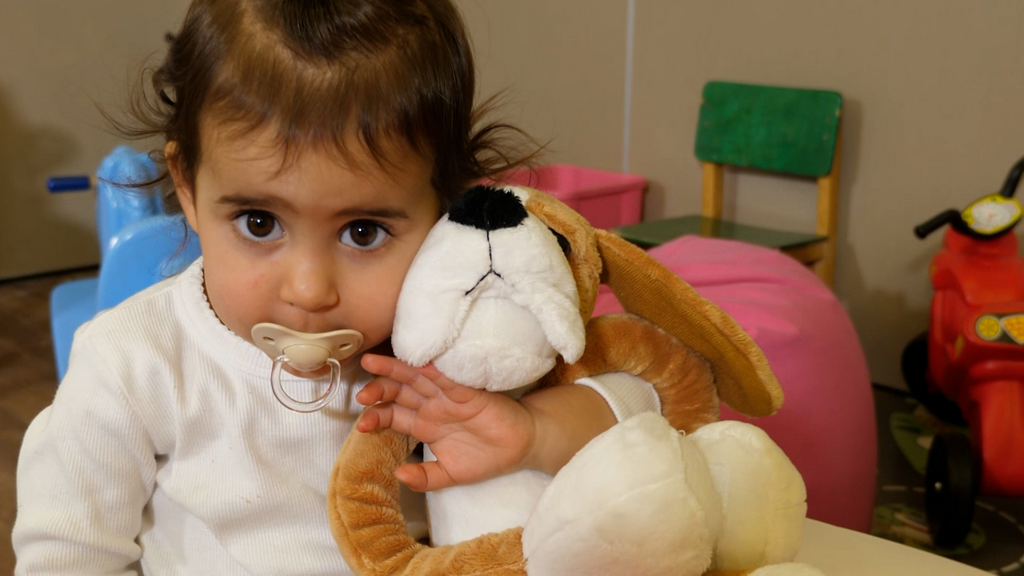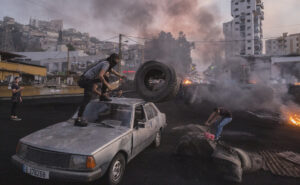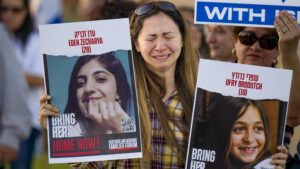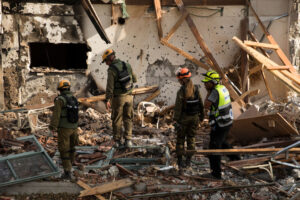Outside the hotel, the Mediterranean Sea winks at the winter sun. There’s a lawn strewn with toys that look like they’ve been abandoned for something more fun. But the sense of tranquillity is deceptive; the deep, dark rings around the eyes of the hotel’s guests tell a different story.
The Shefayim Hotel, 15 minutes north of Tel Aviv, is currently serving as a temporary home for residents of Kibbutz Kfar Aza, which, on October 7, saw 62 of its 950 residents killed and 18 of them taken hostage. Flapping gently in the breeze from the ceiling of the reception area are images of the hostages. There is a banner with their names; yellow stickers are placed next to them if they have been returned. A few weeks ago, two were killed in a horrific tale of friendly fire. Yotam Haim, 28, and Alon Shamriz, 26, had managed to escape their captors in Gaza when they were fatally shot by Israeli forces, along with another young Israeli man.
On the hotel’s front desk, there is a list of funerals and memorials yet to take place. Everyone knows there may soon be more. Five members of the kibbutz remain somewhere underground in Gaza. At least one of them is a young woman — one of the 17 Hamas has refused to part with, perhaps because of the horror stories they would tell.
Today, the residents of the Shefayim Hotel have a roof over their heads, food and medicine. Each family has been offered therapy. You could compare them with the people in Gaza now suffering the repercussions of Hamas’s actions. But that doesn’t make life any easier for them.
“It hurts all the time, it hurts everywhere. I hate waking up in the morning. If I could stay curled up in my bed I would,” says Dafna Rousso, 43, a mother-of-three from Kfar Aza whose husband Uri was killed by Hamas militants on October 7. She looks haunted, but like many Israelis, she is now used to patiently telling her story to the Western media, knowing that if the victims don’t speak, no one will believe what happened.
Shortly after the first rocket attacks were heard, Uri, a member of the kibbutz militia, received a message saying terrorists were in the vicinity. He rushed out of his home so quickly that he didn’t even have time to say goodbye to his wife and daughters. His cartridge showed that he managed to shoot at the terrorists six times. He was probably one of the first members of the kibbutz killed. And he wasn’t the only casualty in Dafna’s family: her nephew was also killed and, as someone born on the kibbutz, she knows everyone who died that day.
Dafna, her daughters and her sister are now renting a flat nearby the Shefayim, but come back to the hotel for therapy sessions, and to be with those who understand what they are going through. There are vague plans for a temporary kibbutz, somewhere closer to the Negev — made up of caravans or temporary housing — where they can begin again, while waiting for Kfar Aza to be rebuilt. But no one knows whether the kibbutz, which was once so popular it had a three-year waiting list, will ever be revived. Dafna doesn’t think it will. How could those who saw their loved ones slaughtered ever feel safe enough to go back there? “To add to the tragedy, we’ve lost our community too,” she says.
Her story echoes across Israel, where nearly a quarter of Jews are reportedly suffering from PTSD. In the south in particular, families are still grappling with the fallout from October 7. Children have finally gone back to school, with too many classes missing pupils who were killed that day. Those who survived are now less likely to be playing Mums and Dads or having picnics with their teddy bears. “Now they are whispering in a corner saying, ‘Sshhhh we need to be quiet, there are terrorists outside,’” says Dr Flora Mor, who has been working with evacuated families for the humanitarian agency JDC. “During the Lebanon war we saw displaced people and fear but it was nothing like what we are seeing now in terms of scale, tremendous pain and trauma. The children aren’t as good at vocalising how they feel so there is a lot of separation anxiety, bedwetting and nightmares. They are very closed off or aggressive. They don’t know how to be themselves. It is like they have forgotten how to play; they are so stressed.”
One of the initiatives she has been trying to implement is one she devised, with Tel Aviv University and the Israeli Ministry of Education, in the wake of the Lebanon war: the Hibuki doll. A sad-looking dog, the toy has long arms and legs that can be Velcroed together, so that children can wear it like a backpack, and feel like they are constantly being held. (The name Hibuki comes from the Israeli word for hug.) More than that, the Hibuki doll is a tool that enables parents and educators to work out what young children are thinking. If they are told they have to look out for the doll, children will often tell their parents that Hibuki has had nightmares or is scared — when they aren’t ready to discuss their own feelings.

Parents can also benefit from talking about another’s emotions when they don’t feel able to articulate their own. Some attend therapy groups during which they discuss how to talk to their children about Hibuki: “The parent is encouraged to ask, ‘What did Hibuki have a nightmare about and how do you think we can make it better?’” says Flora. “When you are dealing with multi-generational trauma, it can help both the parent and the child.”
For the adults themselves, just a few miles down the road from the Shefayim Hotel is Rishpon, a home from home for another group of survivors. Behind a pair of heavy gates lies a camp in what feels like an enchanted forest. Teepees have been set up to offer massage and sound therapy; there’s a candle workshop and a campfire, free food and herbal teas. This was once a retreat for troubled youths, but it has been expanded to become a centre for the survivors of the Nova festival.
Around 3,500 young people were dancing in the desert close to the border when Hamas terrorists invaded and started shooting at them. Of them, 364 were killed; many more were wounded, raped, taken hostage. Rishpon offers them a safe haven, where they support one another and speak to psychologists who are trained in helping them. “I see telling my story as a way of therapy,” says survivor Nehoray Levy, 24. “I lost 10 friends at Nova and it brings them back — I memorialise them for others.”
The trauma can hit him suddenly. “I think I am OK and then suddenly I am not. Last Friday it just attacked me out of nowhere, all these memories. I was crying and shivering for 15 minutes — my mum just hugged me.” There are the memories of seeing his friends killed, of bullets raining down on him; there is the survivor’s guilt, the fear that he could have done more to save them. And, like many Israelis, he’s saddened that he is telling his story in a world that doesn’t seem to care. “I know it is important for me to talk because I am a survivor and there are people who say they don’t believe what happened, or feel they can justify it,” he says. “It is insane to think we would lie about this, but we have another battle that we are fighting on social media just to get people to believe us.”
Many of the Nova survivors need more intensive therapy because of what they witnessed. The “Iron Hug”, a shelter named after the Iron Dome defence system — and set up by the addiction centre Ritorno in the countryside close to Jerusalem — is dealing with Nova survivors who aren’t coping at all. Some of them have lost their jobs and flats because they were unable to function normally, go to work, even get out of bed. Others have been thrown out of home because they were excessively using alcohol or drugs or sex to alleviate their pain.
“When you drink something, or smoke something, or have sex with someone, for a moment you feel good — and you forget about your memories and your flashbacks — but it doesn’t last long and then the cycle begins again,” says Talia Brandes, who is helping to run the shelter. “At first, we didn’t realise that some of them were living on the streets or were homeless. But then one of the girls wrote to me in the middle of the night saying that she could not take it anymore — she said ‘I am sleeping in different beds every night’. That is when we realised, we needed a shelter for them.”
Trauma, of course, is something with which Jews are familiar — older survivors of October 7 speak of its echoes with the Holocaust. And therapy is something Jews are good at. But can you mend a country that seems so broken? The images of those 136 hostages yet to be returned are everywhere; pictures of them flash up at cashpoints. And Israelis are forced to reckon with the fact that, elsewhere in the world, posters of the kidnapped are pulled down, or seen as false propaganda.
“It feels like our entire society is being tortured — all of those hostages are like our children,” says former politician Ayelet Shaked, who is now the Chairwoman of the Friends of Schneider Hospital — the biggest children’s hospital in Israel. She has worked with some of the nation’s most traumatised individuals: the child hostages who have been returned. “Physically they are malnourished, have nits and scabies but those things they can recover from. Mentally, it is a different thing; some of them were physically abused. Some of them were sexually abused. They were not allowed to speak, not allowed to cry.”
And yet, she is hopeful. “They will not break us,” she says. Israel, recently so divided over Prime Minister Benjamin Netanyahu’s planned judicial reforms that many wondered if it could ever recover, is more united than ever. “[Hamas] miscalculated as they saw we were polarised before, but now we know what we have to do: we will fight until the end — until all those monsters that did this are either dead or in jail.”
As for the Israel’s traumatised survivors, “will be looking after them for some time”, says Shaked. “But we will get there.”
Disclaimer
Some of the posts we share are controversial and we do not necessarily agree with them in the whole extend. Sometimes we agree with the content or part of it but we do not agree with the narration or language. Nevertheless we find them somehow interesting, valuable and/or informative or we share them, because we strongly believe in freedom of speech, free press and journalism. We strongly encourage you to have a critical approach to all the content, do your own research and analysis to build your own opinion.
We would be glad to have your feedback.
Source: UnHerd Read the original article here: https://unherd.com/




